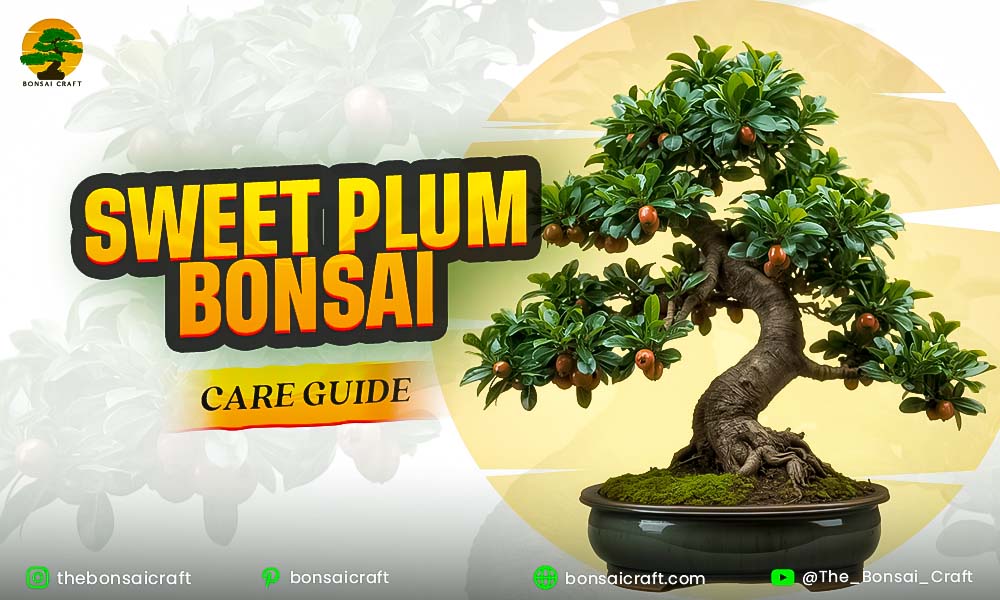
A sweet plum bonsai (also known as Chinese sweet plum bonsai or Sageretia theezans) is one of the most charming and beginner-friendly bonsai trees in the world. Renowned for its shiny green leaves, delicate bark, and small edible fruits, this tree embodies the elegance of traditional Chinese bonsai artistry.
Whether you grow a sweet plum bonsai tree indoors or outdoors, its beauty and adaptability make it a favorite among bonsai enthusiasts. In this comprehensive guide, you’ll learn everything about sweet plum bonsai care, including pruning, watering, repotting, lighting, and flowering tips — all optimized for long-term growth and bloom.
What Is a Sweet Plum Bonsai?
A sweet plum bonsai (Sageretia theezans) is a subtropical bonsai species native to China, known for its glossy green leaves, reddish bark, small white flowers, and edible fruits. It’s often called the Chinese sweet plum bonsai and can be grown both indoors and outdoors.
The bonsai sweet plum symbolizes renewal and patience in Chinese culture. Its naturally twisted trunk and fine branching make it a visually stunning bonsai specimen. When properly cared for, it can produce small purple sweet plum bonsai fruit, adding an ornamental and exotic touch.
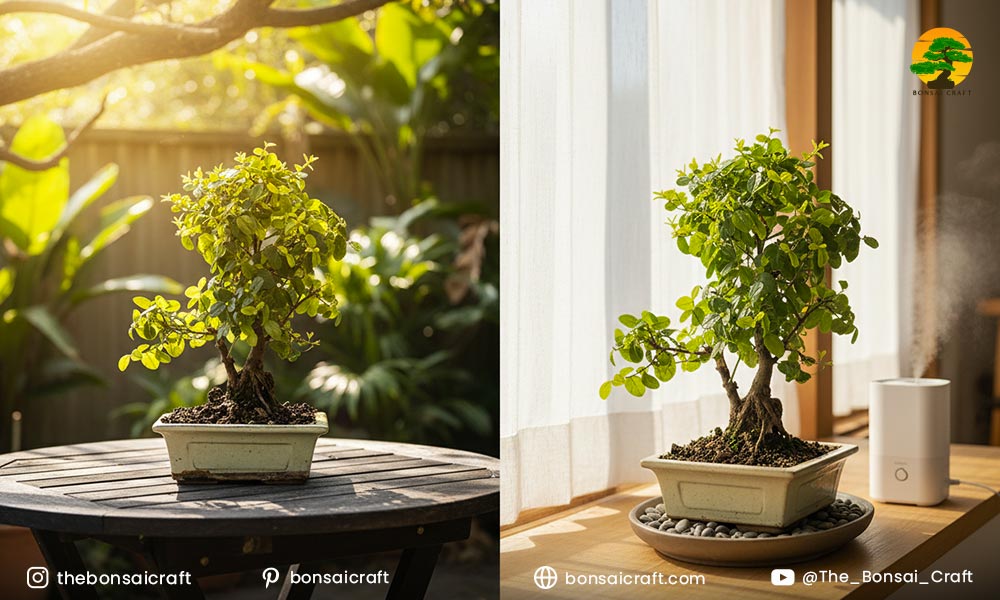
Is Sweet Plum Bonsai Indoor or Outdoor?
A Chinese sweet plum bonsai grows best outdoors in warm climates, but it can also be kept indoors if provided with bright, indirect sunlight and proper humidity.
Detailed Explanation:
- Outdoor placement: Ideal for tropical or subtropical regions; prefers partial sunlight with shade in the afternoon.
- Indoor placement: South or east room, with a window giving 4-6 hours of filtered sunlight.
- Temperature range: 60–80°F (15–27°C) is optimal.
- Humidity: Maintain 50–70% humidity using a pebble tray or humidifier when grown indoors.
💡 Pro Tip: Most Sweet Plum bonsai care instructions say that you should rotate the bonsai to prevent it from stretching and to encourage it to grow bushier.
Watering Your Sweet Plum Bonsai Tree
Watering is most important for the proper care of sweet plum bonsai. The tree thrives in moist, well-draining soil, and the soil must not be too dry or too wet.
- Frequency: Water daily during the growing season (spring–summer) and every 2–3 days in winter.
- Method: Use a fine mist watering can to soak the entire soil surface until water drains from the bottom.
- Check: Stick your finger 1 inch deep — if dry, water immediately.
- Avoid: Letting the soil dry completely or leaving water standing in the tray.
💡 Tip: During summer, mist the leaves occasionally to maintain humidity and prevent leaf burn.
Ideal Soil Mix for Bonsai Sweet Plum
This mixture will provide the needed aeration while also keeping nutrients. Soil nutrients must be restored every year using liquid bonsai fertilizer or organic compost.
Best Soil Mix Recipe:
- 40% Akadama (clay granules)
- 30% Pumice
- 20% Lava rock
- 10% Organic compost or pine bark
This mixture ensures both aeration and nutrient retention. Replenish soil nutrients annually using organic compost or liquid bonsai fertilizer.
Fertilizing the Sweet Plum Bonsai
Feed your sweet plum bonsai tree regularly to encourage lush foliage and flowering.
- Type: Balanced bonsai fertilizer (10-10-10 NPK)
- Frequency: Every 2 weeks in spring and summer; once a month in autumn.
- Method: Apply liquid fertilizer after watering to prevent root burn.
- Pause fertilization: During winter dormancy or after repotting.
During winter dormancy and after repotting, fertilization should be paused. To promote sweet plum bonsai fruit production, use a fertilizer high in phosphorus (for example, 5-10-10) during the blooming season.
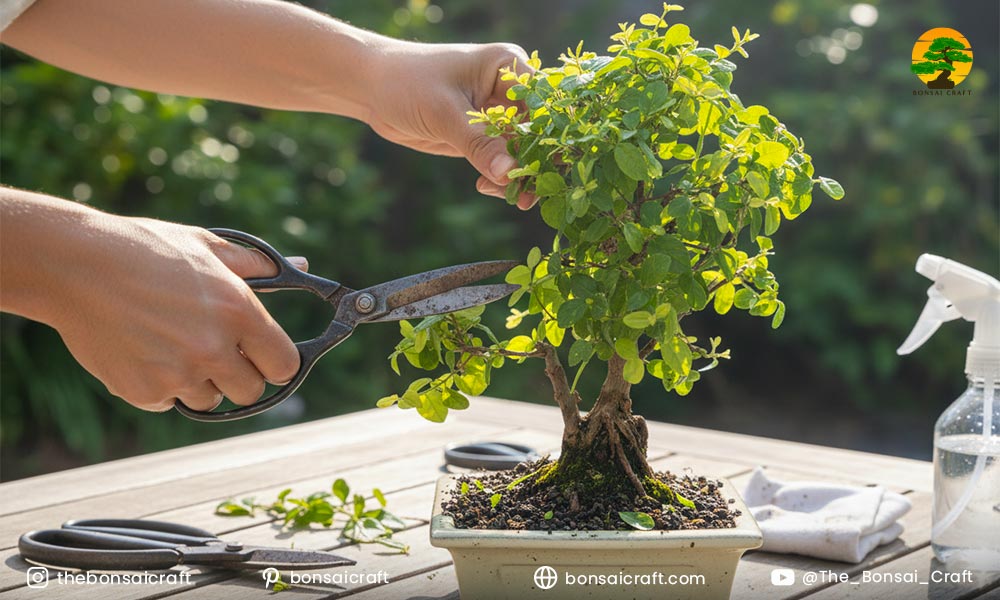
How to Prune a Chinese Sweet Plum Bonsai
Prune your Chinese sweet plum bonsai regularly to maintain shape and promote branching. Trim new shoots after they produce 4–6 leaves, leaving 2–3 pairs to encourage dense foliage.
Detailed Pruning Steps:
- Timing: Late spring or early summer, after flowering.
- Tools: Use sharp bonsai scissors or pruning shears.
- Structure: Focus on shaping branches to create a natural flow.
- Maintenance: Pinch off unwanted new shoots weekly.
- Hard Pruning: Every 2–3 years in late winter to remove old wood.
💡 Tip: Always disinfect your tools before pruning to avoid fungal infection.
Flowering & Fruiting in Sweet Plum Bonsai
The sweet plum bonsai tree produces tiny white flowers followed by round purple fruits resembling miniature plums. These appear in late spring or early summer under ideal conditions.
To Encourage Blooming:
- Ensure at least 6 hours of sunlight daily.
- Use phosphorus-rich fertilizer (e.g., 5-10-10).
- Avoid over-pruning before the flowering season.
- Provide adequate winter dormancy.
The Chinese sweet plum bonsai flowers add visual charm and fragrance, while the fruits add a vibrant accent to your bonsai display.
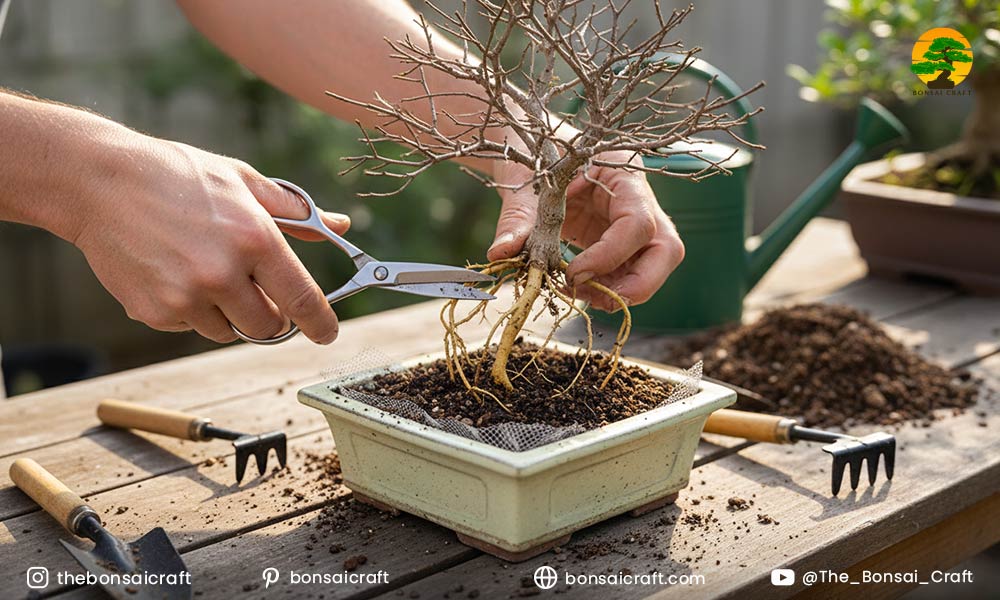
How to Repot a Sweet Plum Bonsai
Repot your sweet plum bonsai every 2–3 years in early spring before new growth begins. Trim one-third of the roots and replace old soil to ensure healthy growth.
Step-by-Step Repotting Process:
- Carefully remove the tree from the pot.
- Prune damaged or long roots using sterile scissors.
- Place mesh over drainage holes.
- Add a base layer of soil mix.
- Reposition the tree and fill with new soil.
- Water thoroughly and keep in partial shade for one week.
Repotting helps rejuvenate roots, improve aeration, and prevent soil compaction.
Wiring and Styling Bonsai Sweet Plum
Wiring allows you to shape your sweet plum bonsai into artistic forms. However, its branches are delicate and should be handled carefully.
- Best time: Late spring after pruning.
- Wiring method: Use aluminum wire and wrap loosely around branches.
- Duration: Leave for 2–3 months; remove before wire marks appear.
- Styles: Informal upright, broom, and slanting styles suit the sweet plum tree bonsai best.
Avoid wiring freshly pruned or weak branches to prevent damage.
Seasonal Care Tips for Sweet Plum Bonsai
|
Season |
Key Tasks |
Notes |
| Spring | Prune, repot, fertilize | Start active growth cycle |
| Summer | Daily watering, pest control | Provide partial shade |
| Autumn | Light pruning, reduce fertilizer | Prepare for dormancy |
| Winter | Keep indoors above 50°F | Water less frequently |
Pests and Diseases
Common issues affecting sweet plum bonsai include:
- Aphids and scale insects: Use neem oil or insecticidal soap.
- Fungal infections: Caused by poor airflow; prune dense foliage.
- Yellow leaves: Usually due to overwatering or poor drainage.
- No flowering: Often from excessive nitrogen or lack of sunlight.
Regular inspection and good hygiene prevent most problems.
Propagating Sweet Plum Bonsai from Cuttings
Feature Snippet Answer:
Propagate a sweet plum bonsai by taking 4–6 inch semi-hardwood cuttings in late spring. Dip the ends in rooting hormone and plant in a moist, well-draining soil mix under indirect sunlight.
Cuttings root within 4–6 weeks under warm and humid conditions. Once established, they can be transplanted into bonsai pots for shaping.
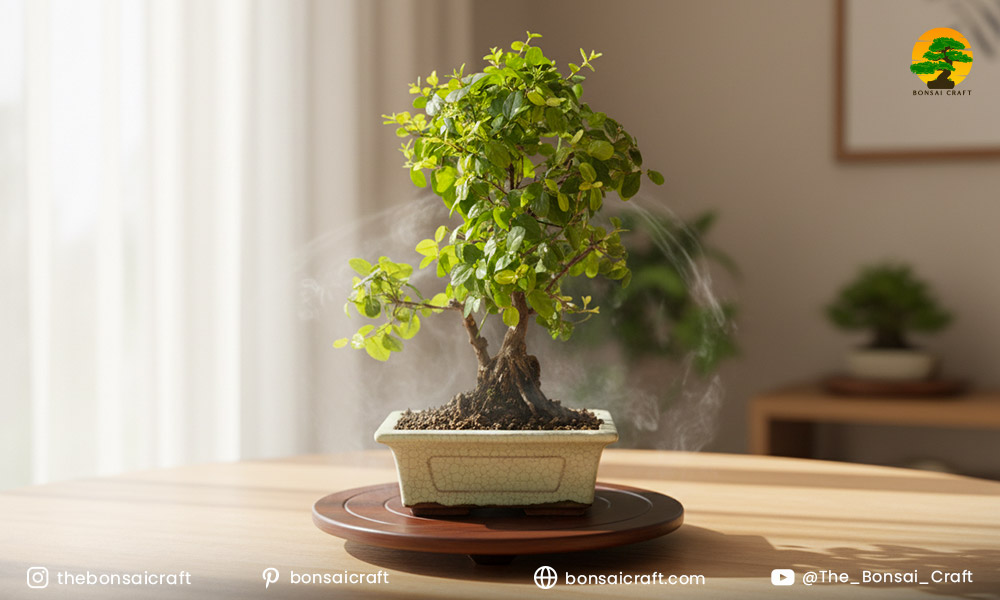
Indoor Sweet Plum Bonsai Care Tips
If growing your indoor Chinese sweet plum bonsai, ensure:
- Bright indirect light near a window.
- Humidity levels of 60% or higher.
- Proper air circulation to avoid mildew.
- Avoid temperature fluctuations or air conditioning drafts.
Rotate the pot weekly and mist the leaves regularly for best results.
Symbolism and Aesthetic Appeal
In Chinese tradition, the sweet plum tree bonsai represents perseverance and renewal, often symbolizing inner strength and purity. Its small fruits and fine branching reflect patience and artistry — key elements of bonsai philosophy.
When displayed, this bonsai pairs beautifully with natural stone or ceramic pots, complementing its delicate bark and lush green foliage.
Conclusion
The sweet plum bonsai combines grace, symbolism, and rewarding beauty in one compact form. Whether grown indoors or outdoors, its glossy leaves, fragrant flowers, and seasonal fruits make it a living piece of art.
Expert Insight:
If you’re new to bonsai cultivation, the Chinese sweet plum bonsai is an excellent choice. It adapts well to different climates, responds beautifully to pruning, and offers visual satisfaction all year round.
By following this sweet plum bonsai care guide, you’ll nurture a healthy, thriving tree that blossoms with charm and meaning for years to come.
FAQs About Sweet Plum Bonsai Care
Can I grow a sweet plum bonsai indoors?
Yes, the indoor sweet plum bonsai can thrive with bright, indirect sunlight, consistent humidity, and good airflow. However, it performs best outdoors in warm, humid environments.
How often should I water a sweet plum bonsai?
Water your sweet plum bonsai tree daily in summer and reduce watering to every 2–3 days in cooler months. Always keep the soil moist but never waterlogged.
When should I prune a Chinese sweet plum bonsai?
Prune your Chinese sweet plum bonsai after flowering in late spring or early summer. Remove excess shoots and maintain a balanced shape without heavy pruning before bloom.
How do I encourage flowers and fruit in a sweet plum bonsai?
To promote sweet plum bonsai fruit, provide full sunlight, use phosphorus-rich fertilizer, and avoid over-trimming before the flowering season.
How often should I repot my sweet plum bonsai?
Repot your bonsai sweet plum every 2–3 years in early spring to refresh the soil and prune roots. This keeps the tree healthy and prevents root congestion.
